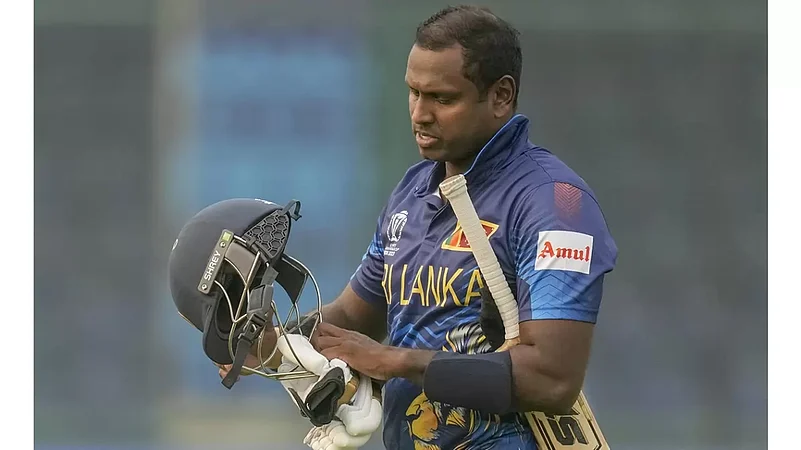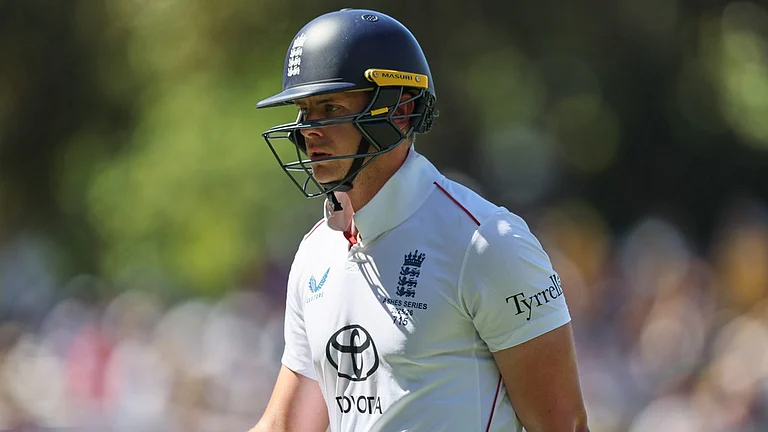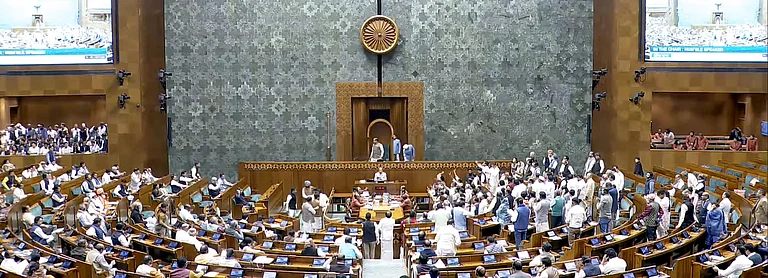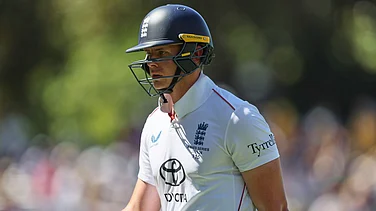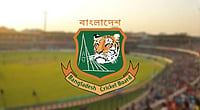Sri Lanka's veteran all-rounder Angelo Mathews became the first international cricketer to be 'timed out' after not being ready to face the ball within two minutes of the fall of a wicket against Bangladesh in a World Cup match in Delhi on Monday. The 36-year-old walked out to bat after the dismissal of Sadeera Samarawickrama but had some issues with his helmet strap and signalled for a replacement, prompting Bangladesh captain Shakib Al Hasan to appeal for a 'time out'. (Match Blog | Streaming | Scorecard | Full Coverage)
Mathews was seemingly not happy with the appeal, and was seen having an animated discussion with umpire Marais Erasmus and Richard Illingworth, explaining that he had some issue with the helmet strap but the Sri Lankan cricketer was asked to leave the field.
According to article 40.1.1 of the ICC rules, "After the fall of a wicket or the retirement of a batter, the incoming batter must, unless Time has been called, be ready to receive the ball, or for the other batter to be ready to receive the next ball within two minutes of the dismissal or retirement. If this requirement is not met, the incoming batter will be out, Timed out.
Article 40.1.2 says: "In the event of an extended delay in which no batter comes to the wicket, the umpires shall adopt the procedure of Law 16.3 (ICC Match referee awarding a match). For the purposes of that clause the start of the action shall be taken as the expiry of the two minutes referred to above."
Post the game, an angry Mathews called it 'disgraceful'. He said, "I haven't done anything wrong. I had two minutes to get ready which I did but there was an equipment malfunction and I don't know where commonsense (had) gone. It was disgraceful from Shakib and Bangladesh."
With many cricket lovers still coming to terms of 'time out' dismissal, here's the list of dismissals from cricket for you to know:
Bowled
A batter is bowled when a bowler's ball/delivery rattles or hits the stumps that are behind him/her directly or after hitting his/her bat or even deflecting off the helmet or any other equipment on the body.
Caught
One of the most common dismissal in cricket - caught. In this, a player is deemed out if the ball strikes the bat and the delivery goes straight into the fielder or wicketkeer's hands. If a bowler catches the ball off his own bowling then it is termed as 'caught and bowled'. If a wicketkeeper or anyone in the slip catches a ball, then it is said to be 'caught behind'. If a batter strikes a ball and it goes up in the air and is caught by a outfielder, it is called as 'caught out'.
Hit Wicket
One of the most rare and bizzare modes of dismissal in cricket is the 'hit wicket'. In this scenario, if a batter uproots the stumps with his bat, pad or any other part of the body whilst hitting the ball, he/she is deemed out via hit wicket. Also, if a fast bowler's delivery strikes the helmet and the latter falls onto the stumps, the batter is still considered to be out via hit wicket.
Hit The Delivery Twice
Another bizzare dismissal that is rarely seen on the cricketing field these days is 'hit the ball twice'. In this case, a batter is out if he/she ends up hitting the ball twice. If the batter ends up striking the ball twice with the bat or any other part of the body, this particular dismissal is called as 'hit the ball twice'.
LBW or Leg Before Wicket
A leg before wicket is nothing but a common dismissal in cricket when the batter is out if the ball strikes the pad if he/she are in line with the stumps. Earlier, the decisions were called on-field by the umpire if the batter is adjudged LBW or not. A batter cannot be out if the ball strikes the bat or the glove and hits the pad. In the current world, a batter can challenge the LBW dismissal by taking a review and send it upstairs via DRS.
Obstructing The Field
According to the Law 37 in the Marylebone Cricket Club (MCC) Laws of Cricket, a batter can be given out if he/she obbstructs the field in a wilful manner or distracting the field through his words and actions.
Run Out
Most common dismissal in the world of cricket is run out wherein a any opposition fielding team player can dismiss the batter via hitting the stumps if he/she does not make the crease on time. This could either be throwing directly at the stumps whilst the batters attempt a run, or a wicketkeepr throws the ball directly at the stumps upon receiving in his gloves. If at time the decision cannot be made on field, the third umpire can send the decision upstairs to the fourth umpire or the TV umpire, who will check all the angles and then take the final call.
Retired Out
Retired Out is a situation wherein a batter feels he/she cannot continue batting on the field and declares themselves as retired out. Retired out is different to retired hurt, wherein the latter allows the batter to walk on to field after he/she has addressed their injury.
Stumped
In stumped, a batter can be given out if he/she does not make the crease or if their footing does not make it in time after a delivery is bowled by a bowler.
Timed Out
In the case of a time out dismissal, the MCC rules state, "After the fall of a wicket or the retirement of a batter, the incoming batter must, unless Time has been called, be ready to receive the ball, or for the other batter to be ready to receive the next ball within 3 minutes of the dismissal or retirement. If this requirement is not met, the incoming batter will be out, Timed out."






